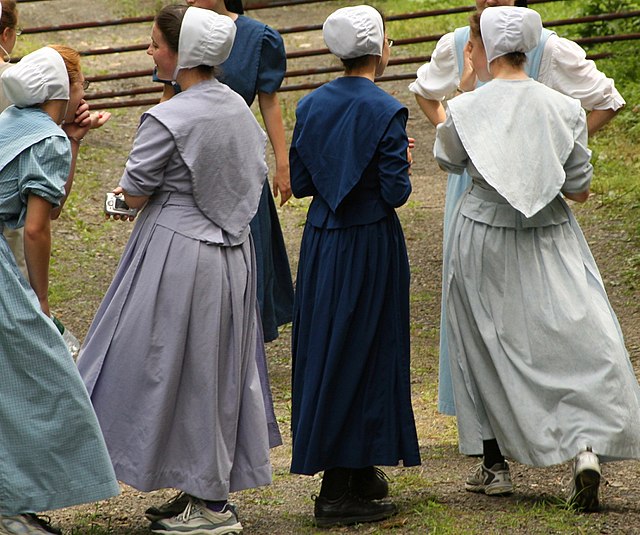Loading AI tools
Branch of Anabaptist Christianity From Wikipedia, the free encyclopedia
Old Order Anabaptism encompasses those groups which have preserved the old ways of Anabaptist Christian religion and lifestyle.[1]


Historically, an Old Order movement emerged in the second half of the 19th century among the Amish, Mennonites of South German and Swiss ancestry as well as the Schwarzenau Brethren and River Brethren in the United States and Canada. The Hutterites are additionally regarded as being Old Order Anabaptists, as they continued the practice of communal living.[2] The Old Order movement led to several Old Order divisions from mainstream Anabaptist groups between 1845 and 1901.[3] All Old Order Anabaptist groups that emerged after 1901 divided from established Old Order Anabaptist groups or were formed by people coming from different Old Order Anabaptist groups.[4]
In 1989, Sandra L. Cronk wrote about the Old Order Anabaptists:
The Old Order Amish and the Old Order Mennonites [...] are not premodern relics from a bygone era. The Old Order movement is a conscious attempt to maintain a style of Christian living based on principles different from those of the larger society.[5]
By the close of the 20th century, there were over a quarter of a million Old Order Anabaptists in North America alone.[6] Old Order Anabaptists enjoy a rich spiritual and community life, which has attracted seekers who desire to become church members of Old Order Anabaptist denominations.[7]
Old Order Anabaptist groups do not have seminary trained pastors and never developed written sophisticated theology. Many practices among the Old Orders stem from the biblical principle of nonconformity to the world, according to Romans 12:2 and other Bible verses.
The avoidance of technologies by Old Order Anabaptist communities is based not on a belief that the technology is in some way evil, but over a concern for the nature of their communities. Community is important to members of Old Order Anabaptist groups, and a technology or practice is rejected if it would adversely affect it. This means that the prohibitions are not usually absolute; a member who would not own a car may accept a ride in a car or other modern transport if a pressing need arises. This basis also means that most Old Orders see no contradiction in having electricity in their milking barn, since that is necessary to comply with regulations on milk cooling, but not in their house.
Other aspects of Old Order Anabaptist life are concerned with plainness, which dictates their distinctive dress. “Plain” to Old Orders is the opposite of showy, fancy or ostentatious, and is considered a virtue opposed to pridefulness, related to humility. It is based on the belief that a person's true worth is spiritual, and so does not lie in their clothes or appearance. The foundation of plain dress comes from the desire to obey the New Testament's instructions against outward adornment and fashionable, expensive clothing.
Nonresistance and loving one's enemies is a belief held by all Old Order groups.
According to Donald Kraybill and Carl Bowman the following additional practices are common among the Old Orders:[8]
All Old Order Anabaptist groups dress plain and all their forms of dress share the same roots in the Pennsylvania Quaker dress style.[9]
All Old Order Amish groups are horse and buggy groups, including the New Order Amish. Among the Old Order Mennonites, there are both horse and buggy and car driving groups. The same is true for the Old Orders among the Schwarzenau Brethren. The Old Order River Brethren are a car driving group, except a small subgroup of about half a dozen members, that still use horse and buggy transportation. Old Order German Baptist Brethren are a group of 3 congregations in Ohio who still use horses and buggies, and do not have electricity in their homes.[10][11] The Hutterite groups are entirely car-driving.[12]
Almost all Old Order Amish groups speak a German dialect in everyday life, either Pennsylvania German, or one of two Alemannic dialects (Swiss Amish), or in the case of the Hutterites—Hutterite German. Among the Old Order Mennonites, all horse and buggy groups, except the Virginia groups, speak Pennsylvania German. The car driving groups of Old Order Mennonites shifted to English in the second half of the 20th century. The groups from which the Old Order Schwarzenau Brethren and Old Order River Brethren split, had already started shifting to English in the 19th century and mostly completed it in the first half of the 20th century.
There are about 350,000 Old Order Amish, 60,000 to 80,000 Old Order Mennonites, about 7,000 Old Order Brethren, about 350 Old Order River Brethren, and around 50,000 Hutterites.[13] The Amish and Mennonite Old Orders have growth rates between 3 and 5 percent a year, in average about 3.7 percent. Old Order Schwarzenau and River Brethren groups in contrast have low growth rates and were even shrinking during the 20th century. All English speaking groups tend to grow much more slowly than their German speaking brothers.
The Old Order Anabaptists comprise the following groups:
Seamless Wikipedia browsing. On steroids.
Every time you click a link to Wikipedia, Wiktionary or Wikiquote in your browser's search results, it will show the modern Wikiwand interface.
Wikiwand extension is a five stars, simple, with minimum permission required to keep your browsing private, safe and transparent.